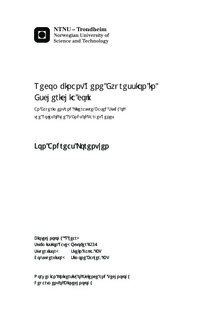Recombinant Gene Expression in Escherichia coli: An Experiment and Literature-Based Study of the Roles of the 5'-Ends of Target Genes
Master thesis
Permanent lenke
http://hdl.handle.net/11250/245900Utgivelsesdato
2012Metadata
Vis full innførselSamlinger
Sammendrag
Experiment-based study: The 5 -untranslated region (5 -UTR), and the DNA region corresponding to it, have been shown to have a significant influence on the expression of genes both at transcriptional and translational level. Since transcription and translation are two independent mechanisms a 5 -UTR sequence will probably not be optimal for both. The suggested solution presented in this study is to design a long 5 -UTR composed of one transcription stimulating and one translation stimulating region. The stimulating regions consist of 5 -UTR variants independently identified as transcription or translation stimulating by screening for the desired trait, as well as translation stimulating 5 -UTR variants designed using a bioinformatics tool.The results indicated that 5 -UTR fusions tend to introduce limiting factors yielding a reduced gene expression. However, some 5 -UTR fusions successfully resulted in high gene expression and one variant surpassed both of its components showing a possible additive effect of stimulating both transcription and translation in the form of 5 -UTR fusions. This indicates that testing a relatively small number of different sequences gives a good chance of success. The method also proved viable to increase the expression of low expressive 5 -UTR variants while maintaining low uninduced expression. In addition 5 -UTR fusions containing in silico designed translation stimulating regions have the potential of reaching expression levels on par with the levels reached by fusions containing 5 -UTR variants identified through screening. Literature-based study: The nucleotide sequence at the gene 5 -end has a great influence on the expression level of genes, being the location of central mechanisms like transcription and translation initiation. Because of this the 5 -end sequence is an important target when designing genes for recombinant expression. This review will focus on recent research trends, covering the traits of the 5 -end that influence gene expression, as well as on approaches and tools targeting this region that have been utilized or show potential to be used to achieve desired recombinant expression levels in E. coli. In recent years it have become evident that the entire 5 -untranslated region as well as the initial coding sequence has great influence on gene expression, showing that there is more to designing genes for recombinant expression then picking a strong promoter and an optimal SD sequence.
